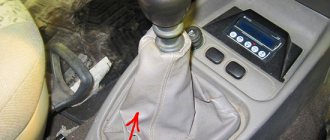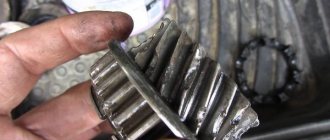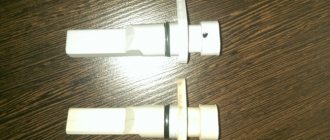The clarity of gear engagement and the operation of the entire shift mechanism often worries owners of cars with a manual transmission. A common problem is that after starting the engine, one or more gears are engaged with great effort or not completely, it is not possible to change gears, at the moment of switching on, extraneous noise is heard, unnecessary vibrations appear, etc.
Such malfunctions appear unexpectedly, and difficulties when shifting gears can increase gradually. Speeds may be difficult to switch on “cold” and/or “hot”. It is noteworthy that gears in a manual transmission often shift normally when the engine is turned off.
Read in this article
Cabin wires
When the fuse is fully operational, everything is in order with the plug, and the Kalina does not engage reverse gear, look at the switch located under the decorative cover near the gearshift lever itself. There are two wires connected to this switch. They are connected to each other. If the transmission started to turn on normally, then the reason was precisely in the switch.
You can measure the voltage on the wires using needles. There must be at least 12 V at the switch. If you don’t have a multimeter, you can measure the voltage using a light bulb. If it does not light up, this indicates a broken wire. This usually happens in the place where the clamp is installed on the pallet. This easily explains the question: why reverse gear does not engage on the Lada Kalina.
The clamp is removed and compressed at the bottom of the fastener. Next, disconnect the lamp switch connector. Then take out the entire tourniquet. The broken wire will be visible immediately. What to do next? The cord is connected to a piece of good wire - you can make a simple twist.
But it's best to solder the connection. Then everything is assembled in reverse order. If the transmission is engaged, then the problem is solved.
Comparison of manual transmission 2180 and manual transmission 2181
The difference between the two boxes is significant:
- Instead of rigid rods, a cable is used (Japanese company Atsumitec). Due to this, vibration on the body and gearshift knob is reduced.
- Multi-cone synchronizers were installed in 1st and 2nd gears. This increases the service life of the components and reduces the effort when engaging gears.
- The clutch diameter was increased to 215 mm. In this regard, it was necessary to use a different crankcase, and place the starter not along the box, but along the engine.
- The bevel angle of the synchronizer teeth was reduced (from 125 to 100º), as well as the preload force (from 150 to 70 N). This made switching easier.
- The gear selection mechanism has been newly developed (Schaeffler Group).
- The gear selection mechanism was moved from bottom to top. This made it possible to eliminate oil leaks and make gear shifting easier in cold weather.
- The design of the gear selection mechanism includes a selector plate, providing a clear gear shift pattern.
- The mechanism includes a lock to prevent accidental reverse gear.
- The oil volume in the gearbox decreased from 3.3 liters to 2.2.
- From the factory, semi-synthetics are poured into the gearbox instead of mineral water.
Gearbox linkages and rods
I remember I was “infuriated” on the VAZ 2114 by the fact that the gearbox lever was swinging from side to side like a “spoon in a glass”; I always wanted to make it stiffer, in some way. But there was only one way, to climb down the car and play with the scenes and rods. In principle, they can be released, tightened, the lever can be adjusted for tilt, etc. In general, I played around, but I noticed that if I press the lever too hard to the left, the ability to engage gear (first and reverse) disappears. This manifests itself when the car is not running, I’m already silent about the running engine.
Often the slides break, or they fly out of the fastenings, or the wear is simply enormous and they need to be replaced (this happens with high mileage). The very first thing we do is climb under the car and look at them.
Causes of gearbox failure
The complex mechanism constantly works under load and under extreme conditions. Constant vibration, rising temperatures, dust and dirt. If one or more speeds fail to turn on, you should check:
- cable tension and integrity;
- fastening the scenes;
- wear on the clutch disc;
- petals on a basket;
- bearing integrity;
- plug condition.
Clutch
When the clutch discs wear out, the pedal moves up and its position becomes higher than the others. In this case, when turned on, a crunching sound may be heard and the lever does not move, as if it is resting against an obstacle. You should not force the assembly, as this can lead to more serious damage - the gears will fly.
You can check by removing the rubber plug. The destroyed disc leaves fibers that look like tangled strands of hair. If such a phenomenon occurs, then a new clutch disc should be installed.
Cable
Due to constant loads, the cable stretches and must be periodically adjusted and tightened. In this case, the VAZ 21093 does not engage the first and second gears, and the rear may also fail. To fix the breakdown, you need to drive into the pit and tighten the cable. If it is worn out, replace it immediately. You can do this yourself.
A similar breakdown can also manifest itself in the failure of the gears to engage while the engine is running. Sliding along the splines is limited and fixation does not occur.
Basket
The reason for difficult shifting of individual gears, especially if there is a crackling sound that gradually fades during movement, may be the destruction of the spacer ring in the basket
Notice that there are drops of oil on the outside. Then remove the basket and check the O-ring and disc blades
Pay attention when purchasing new parts, because on some models the disk is missing and then you have to install pins and secure it yourself.
Backstage
A loose link must be tightened with an assistant. No special knowledge or skills are required, just the ability to hold the lever in the desired position while you crawl under the car and tighten the bolts. When the scenes on the VAZ 2109 are loosened, the speeds do not engage, and especially the rear ones.
Place the car on a hole or hill to have access to the bottom. Set the lever to neutral if several speeds do not engage. When only the reverse gear does not work, make adjustments using it. An assistant must hold the shift knob in the specified position without moving it anywhere.
It is necessary to loosen the bolt from below by 13, check the engagement of the gears, and having installed everything in place, tighten the bolt. If there is a problem with several gears, everything is done the same way, but it is set to neutral, or rather the shift knob is in the middle position. You can watch the video on how to do this.
Fork
Most often it fails on the road. If you slow down at a traffic light, the speed will not turn on to continue driving. A crack that forms on the fork body can lead to its destruction at any time, even under minor loads.
CPT diseases
VAZ 2110 owners often complain that the first gear is difficult to engage or crashes.
Possible reasons:
- often the synchronizer is to blame;
- perhaps the clamp spring has burst, the lever is hanging loose, the speeds are switched on as desired;
- The stem and fork may need replacement.
Another complaint is that second gear is difficult to engage and often gets knocked out.
Here you can suspect the main culprits:
- the second one flies out most often because the gear teeth do not mesh well with the clutch that turns on the speeds;
- The tips of the gear teeth and clutch are already worn out, so the speed is difficult to engage. If you don’t intervene, it will soon fly out;
- as an option, when it knocks out on bumps, the clutch dies.
Sometimes (albeit rarely) when the second one does not turn on well enough and falls out, replacing the retaining spring helps. If the speeds often drop out, some of them are difficult to turn on, which means that half-measures will no longer help - the box needs to be overhauled.
Whether you do it yourself, or go to a service center where they will repair it for you and also adjust the gear shift mechanism, decide for yourself, based on your own experience and skills.
Reverse does not engage - reasons
- Before you start drastic actions and disassemble “anything and everything”, check the gear shift lever itself, this may be the reason. The linkage and cardan are quite often the cause of this breakdown. The splines could also be worn out or the clamp loosened. In this case, you will need an inspection hole.
- A faulty release bearing is an option. Although it is unlikely, since in this case all gears without exception would be engaged with a characteristic crunch and with great effort.
- Reverse gear may stop engaging due to problems in the reverse gear locking mechanism; in order to confirm or refute this, remove the gear shift knob along with the dashboard between the seats and perform a visual inspection.
In my case, the problem was precisely the faulty wiring of the transmission lock solenoids (break or fracture), how I solved this issue, read on.
How to check and repair the reverse gear locking mechanism of a Lada Kalina with your own hands?
Theory:
Power comes to the solenoid through a switch ring located on the gearshift knob. It works like this: you lift the ring, thereby turning on the solenoid, the rod is pulled into the solenoid, which leads to unlocking the reverse gear. You can then engage reverse gear by moving the gear shift knob. Next, the “limit switch” located on the box is turned on, and the rear stops are turned on, and an intermittent sound signal is turned on in the cabin.
Here is the solenoid control circuit:
Through fuse F21, +12 Volts are supplied to solenoid L1, using switch S1 on the handle, the circuit is closed to ground, after which the solenoid coil is activated.
1. The 10A fuse we need, F21, is located 8th on the left in the fuse block. Take it out and check it with a tester. If the fuse is defective, replace it with a new one of the same rating.
2. Now it's time to check the switch, to do this, lift the cover on the handle, after which you will see the connector connected to the switch. Carefully turn it off.
3. Using a paper clip, you need to close the contacts of the connector from which the wires go down under the Kalina floor. Now try to engage reverse gear; if it does, the switch is faulty. If not, continue troubleshooting.
4. Remove the connector from the solenoid, install two pins in it, then use a tester to measure the voltage, the device should show 12 volts. In addition, you need to load it with a light bulb. A 5-Watt 12 V is suitable for this; if the light bulb does not light up, you have an open circuit, and the voltage is explained by the resistance formed due to copper oxide. As practice shows, 99% of breaks and fractures occur in the harness, in the place where the clamp is installed on the pallet.
5. Remove the clamp by squeezing its fasteners from below.
6. Disconnect the connector from the stop switch and remove the entire harness. Remove the electrical tape from the corrugation and remove the wires. If the wire is broken or broken, you will notice characteristic signs.
7. Using wire cutters, pinch off the wires and connect others of similar cross-section and diameter. It is better to solder the twist itself and insulate it or use heat shrink. If desired, you can put on another corrugation, the main thing is that moisture does not penetrate, otherwise the problem will very soon recur. I personally threw away the clamp, if you need it you can leave it. Secure the harness with a plastic clamp.
8. Connect the connectors and check the operation of the solenoid. Failure of the solenoid itself is a fairly rare phenomenon; to check it, connect a tester; the resistance should be 2.2 Ohms. If there is still a problem, you will have to drain the oil from the box. There is a way. in which it is fashionable not to drain, but here a certain skill is required, the main thing is to sharply plug the hole with something, and then screw in a new one. A little oil will, of course, spill out, but you can add it back. When installing a new solenoid, do not forget to lubricate the threads with sealant, if this is not done over time, oil will begin to ooze along the threads.
If previous checks did not lead to anything, there are several options left, namely:
- The mechanism for fastening the gear selection mechanism has failed;
- The fixing bolt has been cut off;
- The spring in the gearbox has broken.
The worst thing is that each of these three points requires mandatory dismantling of the gearbox, and this is already in the category of “serious repairs”, which is not always within the power of an ordinary driver, and it will take much more time than in the case of a rocker or lock transfers.
That's all I wanted to say! I hope I helped solve the problem. If after all the above manipulations and checks you still do not engage reverse gear, seek help from a specialist or go to a service station.
Why is it difficult to engage manual transmission gears?
Problems with manual gear shifting most often occur for the following reasons:
- The most common problem is clutch failure. In such a situation, reverse gear turns on with a bang. This happens because the gear overlaps the tooth. Reverse speed is the only gear in the box that does not have synchronizers. For this reason, clutch failure is so obvious on it.
- The second reason is a defect in the mechanism responsible for selecting the gear. This breakdown occurs when the car is stationary and you try to shift into gear.
- The third is severe wear of the gearbox synchronizers. Mostly, breakdowns occur with those that are most often used. These are first, second and third gear. Severe wear of the synchronizers only appears when switching while driving.
To prevent possible gearbox malfunctions, perform regular maintenance, change the oil on time, and in case of minor failures, rush for diagnostics. This will save you time and money in the future.
Watch the video for what not to do with a manual transmission:
https://youtube.com/watch?v=FITVjH2s8es
What to do if it is difficult to engage reverse gear?
If you have difficulty engaging reverse gear, do one of the following:
- When you feel that the gear has not reached the end, release the clutch slightly, and the gear will be inserted all the way.
- Fully depress the clutch and only after a few seconds engage reverse gear.
- Depress the clutch, set the gear to neutral and release the clutch. After this, press down and engage reverse gear.
- Shift into reverse through another gear. For example, first engage 4th and then shift to reverse.
How to properly engage reverse gear on a Hyundai Solaris, watch the video:
It's hard to engage first gear
Many drivers who encounter this situation try to force the gearbox selector to engage 1st speed. But this is fundamentally wrong and should not be done this way.
In this situation, it is necessary to use the regas method. Its essence is as follows:
- While driving in second gear, depress the clutch and set it to neutral and then release the clutch.
- After this, you need to press the gas pedal, increasing the speed to 2.5 thousand.
- The next step is to engage the clutch again by pressing the pedal all the way and turn on the first gear on the gearbox. If you still have difficulties with this, then you need to repeat it, because... You gave too little gas, there were too few revolutions.
- If all the steps are performed correctly, the first speed will turn on without any difficulties or sounds.
However, this method should not be used on an ongoing basis when it is difficult to engage 1st gear. This method is temporary in order to at least get to the service station without any problems. In any case, the box will have to be repaired.
What to do when it’s hard to engage 1st gear on a car, watch the video from a driving instructor:
The procedure for replacing synchronizers requires experience, relevant knowledge and special tools, so it is better to contact professionals. Automotive technicians will perform the replacement quickly and efficiently, and will also advise you on further operation and maintenance of the box.
For those with automatic
If your car has an automatic transmission. It will not hurt you to know the modes in which your machine can operate:
- P – For parking and starting the engine. Switching to this mode is possible only after the machine has completely stopped.
- R – To move backwards. Switching to this mode is also possible only after stopping the car and with the brake pedal pressed.
- N – Neutral. When the engine is completely disconnected from the gearbox.
- D – Moving forward without restrictions on gear shifting (the most commonly used operating mode of the automatic transmission).
- D3(S) – Low gears for climbing and braking engines on descents.
- D2 – Mode for difficult conditions (slippery or mountainous roads). Gears above second are not shifted, that is, only first and second gears are engaged.
- D1(L) - Movement occurs only in 1st gear, used off-road on mud, snow or ice, where you need to drive without changing the throttle, and also to overcome steep climbs.
Why is it difficult to engage manual transmission gears?
Problems with manual gear shifting most often occur for the following reasons:
- The most common problem is clutch failure. In such a situation, reverse gear turns on with a bang. This happens because the gear overlaps the tooth. Reverse speed is the only gear in the box that does not have synchronizers. For this reason, clutch failure is so obvious on it.
- The second reason is a defect in the mechanism responsible for selecting the gear. This breakdown occurs when the car is stationary and you try to shift into gear.
- The third is severe wear of the gearbox synchronizers. Mostly, breakdowns occur with those that are most often used. These are first, second and third gear. Severe wear of the synchronizers only appears when switching while driving.
To prevent possible gearbox malfunctions, perform regular maintenance, change the oil on time, and in case of minor failures, rush for diagnostics. This will save you time and money in the future.
Watch the video for what not to do with a manual transmission:
https://www.youtube.com/watch?v=FITVjH2s8es
What to do if it is difficult to engage reverse gear?
If you have difficulty engaging reverse gear, do one of the following:
- When you feel that the gear has not reached the end, release the clutch slightly, and the gear will be inserted all the way.
- Fully depress the clutch and only after a few seconds engage reverse gear.
- Depress the clutch, set the gear to neutral and release the clutch. After this, press down and engage reverse gear.
- Shift into reverse through another gear. For example, first engage 4th and then shift to reverse.
How to properly engage reverse gear on a Hyundai Solaris, watch the video:
It's hard to engage first gear
Many drivers who encounter this situation try to force the gearbox selector to engage 1st speed. But this is fundamentally wrong and should not be done this way.
In this situation, it is necessary to use the regas method. Its essence is as follows:
- While driving in second gear, depress the clutch and set it to neutral and then release the clutch.
- After this, you need to press the gas pedal, increasing the speed to 2.5 thousand.
- The next step is to engage the clutch again by pressing the pedal all the way and turn on the first gear on the gearbox. If you still have difficulties with this, then you need to repeat it, because... You gave too little gas, there were too few revolutions.
- If all the steps are performed correctly, the first speed will turn on without any difficulties or sounds.
However, this method should not be used on an ongoing basis when it is difficult to engage 1st gear. This method is temporary in order to at least get to the service station without any problems. In any case, the box will have to be repaired.
What to do when it’s hard to engage 1st gear on a car, watch the video from a driving instructor:
The procedure for replacing synchronizers requires experience, relevant knowledge and special tools, so it is better to contact professionals. Automotive technicians will perform the replacement quickly and efficiently, and will also advise you on further operation and maintenance of the box.
Transmission problems
- To post comments, please login or register
In my Lada Granta, 1st and 2nd gears are somehow a little difficult to engage. What could this be or is this normal for this car? If anyone has the same problem, please share the solution.
- To post comments, please login or register
This happens when the box is installed at an angle. I think if you go to a mechanic, he will set it up correctly and everything will turn on fine.
- To post comments, please login or register
The transmission was transferred from Kalina, so nothing new was expected! The main thing was not to tear the box - then it would last a long time. If you change gears very actively. then not only this box will break!
- To post comments, please login or register
after 8,000 miles, 3-4 gears began to engage with a crunch. At the service center, I don’t know why this is happening. They said that they couldn’t help. What could this be? Help please
- To post comments, please login or register
Maybe the clutch for 1st and 2nd gear has not yet been developed?
- To post comments, please login or register
It seems to me that there is nothing surprising here, the car is practically without mileage, if this was the case when buying, then I think that some components simply have not yet gotten used to it.
- To post comments, please login or register
In my opinion, you need to set the clutch travel, perhaps it is long on your car, which is why you may have problems engaging certain gears.
- To post comments, please login or register
There was such a situation on the Lada Kalina. A friend went to Vanya Kulibin’s dadi to the garages. Uncle Vanya adjusted the rocker for a certain amount of money and the problem went into another world. A friend filled it with expensive gear oil and is driving happily.
- To post comments, please login or register
Good afternoon. I have a Lada 2110 and there is a problem with it: when shifting to 2nd gear, my car jerks a lot, why? (If you switch to other gears, everything is fine).
- To post comments, please login or register
If you go to a specialist, be sure to have him look at the drawstring on your box, there may be a problem there.
- To post comments, please login or register
The car drove 35,000 and crunched into 3rd gear. after that 3,4,5, the transmission disappeared. 1,2, the vibration turns on the scenes..
- To post comments, please login or register
Dear Yarusik, you need to go to a car repair shop and have the box repaired.
Principle of operation
The working diagram of the gearbox is as follows. The drive shaft receives rotation from the driven clutch disc and transmits it to the intermediate one. If the gearbox is set to neutral speed, there is no engagement of the intermediate shaft gears with the driven one, the car is immobilized, since rotation is not transmitted.
When a gear is engaged, the driver engages the driven element gear with a specific intermediate gear. And rotation begins to be transmitted from the driven shaft to the wheels. The car starts to move.
The necessary gears are engaged by a control unit consisting of three sliders and forks. Each of the forks is equipped with a special groove of the element. That is, the driver, using the gearshift lever and a special rocker, acts on a certain slider, moving it to one side. In this case, the fork on the slide pushes the gear, and it engages. The change in gear shift speed is influenced by engaging gears of different sizes and numbers of teeth.
To prevent the slider with the fork from returning to its original position, the box control unit is equipped with latches. The latter are spring-loaded balls that fit into grooves on the sliders. That is, the slide has grooves in certain places.
When moved to the desired position, the ball retainer jumps into the groove, eliminating the return of the slider. When changing speed, the driver must apply pressure on the slider that exceeds the force of the detent spring so that the ball pops out.
This is a simplified description of the design and operating principle of a manual transmission.
Typically, classic models work according to this scheme. On some cars the scheme may be slightly different, but the essence of the work is the same - the slider with the fork acts on the gear.
In some cars, the slider in the gearbox, which is responsible for engaging the first gear, also ensures that the reverse gear is engaged. It happens to them that first and reverse gears are difficult to engage
Of course, this breakdown cannot be ignored
On other gearboxes, first and reverse speeds are separated and different sliders are responsible for turning them on. In such cars, problems with engaging first gear may not be reflected in engaging reverse gear.
There are several options why first gear does not engage well. It also all depends on how the cause manifests itself - it is impossible to turn it on, and everything is accompanied by a metallic grinding sound from the side of the box, or the speed turns on, but immediately turns off on its own.
How to check the clutch?
The car engine can help indicate a malfunction of the clutch, not the gearbox. If, with the engine turned off, all speeds are switched on easily, no problems arise, but when the engine is running, first and reverse gears are difficult to engage, or impossible to engage at all, you should pay attention to the clutch.
The reason that the clutch “leads” is often due to its incorrect adjustment.
Types of boxes
What to do if reverse gear is difficult to engage? The answer to this question is not difficult to find; you need to look at the structure of the checkpoint. First of all, you need to study the features of gear shifting. This usually causes a problem with the reverse gear. Modern manual transmissions use 2 types of switching:
- The lever goes into the box and acts on the switch fork through a ball joint;
- Switching occurs using the scenes.
Direct switching
. Various limiters are usually installed here to avoid engaging another gear instead of reverse. On a VAZ classic, for example, the hinge needs to be pushed down so that you can engage the gear. It is with this limiter that problems usually arise. Its increased wear prevents it from engaging reverse gear in a timely manner. To fix the problem you will have to disassemble the box. Usually this mechanism is changed along with the fork and support.
Rocker switch
. There may be several reasons for this. First, let's look at the structure of this system. The lever here does not go into the box. A pair of scenes (sometimes cables) go from it to the gearbox. One of the scenes is responsible for changing gears, and the other for selecting them. Shifting problems occur when the lever that engages reverse gear is unscrewed. To fix the problem, just drive into the inspection hole and screw the bolt into place.
Clutch faults
Often the reason why first gear does not engage well is not the gearbox itself, but the clutch.
Modern gear transmissions are equipped with synchronizers that equalize the speed of rotation of the gears, ensuring ease of engagement.
However, the first speed is not equipped with a synchronizer. If the clutch “drives”, then when the pedal is depressed, the transmission of torque from the engine to the gearbox does not completely stop.
Because of this, there is a difference in the rotation of the shafts and gears of the first gear, in particular.
It is quite possible that the reverse gear will also not engage, or it will be difficult to engage. Moreover, if you manage to engage the gear, the car begins to move even with the clutch pedal fully depressed. An additional sign of clutch problems is that the car jerks when changing gears, especially if any of the gears do not have synchronizers.
Reverse gear does not engage: common breakdowns
So, if engaging reverse gear is difficult or completely impossible, this breakdown is a common problem that can be encountered in different vehicles when changing gears.
Moreover, the rear does not engage both on manual and automatic transmissions (the reverse speed of the automatic transmission has disappeared)
Naturally, in such a situation, it is important to discover the cause of the malfunction and eliminate the breakdown, since it is simply impossible to operate the car normally without reverse gear (the vehicle is actually deprived of reverse gear). Let's figure it out
Let's start with a manual transmission and consider the question of why reverse gear does not engage in a manual transmission. First of all, with a manual transmission the reverse gear fails much more often than with an automatic transmission. As a rule, the first signs of problems are a grinding, crackling or crunching sound in the reverse gear when engaged, the reverse gear is difficult to engage, it is difficult to engage the speed after a while, etc.
As for the main malfunctions, we can highlight the following:
The clutch does not disengage completely. As you know, the clutch connects the engine and the gearbox, and at the moment of changing gears the driver must depress the clutch pedal and “disconnect” the internal combustion engine from the gearbox. After engaging the gear, the pedal is released, the clutch “closes” and the torque is again transmitted to the wheels.
So, if the clutch is not completely disengaged, the gearbox is not completely disconnected from the engine. This leads to the fact that all gears are difficult to engage. At the same time, on many cars, first speed and reverse do not have synchronizers. As a result, clutch problems are most noticeable when engaging reverse gear.
In such a situation, when trying to engage a gear, a crunching and grinding noise is heard in the box
To eliminate the breakdown, you need to pay special attention to the clutch (condition of the clutch disc, basket, release bearing, etc.). You also need to check the clutch adjustments, the quality of the pedal, etc.
The oil level in the gearbox is low or the gear oil has lost its properties. As practice shows, there is a common misconception among drivers that the manual transmission is filled with oil for the entire service life of the car. In fact, a maximum of 100 thousand km. Even the highest quality gear oil becomes unusable. And this is subject to fairly gentle operation.
If the car is used in difficult conditions (driving around the city, irregular pace, constantly switching speeds “up” and “down”, short trips, temperature changes, etc.), then the oil in the box requires replacement every 50-60 thousand. km. The fact is that the properties of the liquid change, additives are activated, dirt, products of mechanical wear of the box and various deposits accumulate in the oil.
The gearbox linkage needs to be adjusted; the rods or gearbox drive levers are deformed. Often, it is after diagnosing the condition of the rocker that it becomes clear why reverse gear on a Lada and various foreign-made cars (especially old ones or with high mileage) does not engage. Owners of front-wheel drive VAZ models are well aware that a poorly adjusted rocker is the reason why the reverse gear does not engage or is knocked out.
The solution in such a situation is to adjust the manual transmission gate, which can significantly improve the clarity of the inclusions and obtain the necessary softness. Also, in some cases, owners remove the standard mechanism and install a short-throw slide, but in this case you need to be prepared for the need for more careful adjustment. As for the gearbox rods and drives, these elements must be inspected for possible damage or breakage, after which they are replaced.
Design features of the gearbox. Often on budget cars, reverse and first gears do not have synchronizers. The absence of these elements, on the one hand, simplifies the design of the box, but on the other hand, difficulties arise when engaging reverse gear and first speed.
About the uniqueness of the cable unit for Granta
Replacing the rods and rockers with a cable system in the Lada Granta was intended to reduce the impact of vibration. At first, the developers were inclined to build a hydraulic circuit for the switching unit, similar to many foreign cars. Such a decision would have caused an additional increase in cost, affecting the price of the car, so the manufacturer chose a path that would take into account the financial capabilities of a wide range of buyers. The final increase in the cost of the car due to the use of a progressive cable unit reaches 5 thousand rubles. This is quite acceptable, since the price increase is insignificant, and the transmission unit is reliable.
Note that the cable gearbox has acquired more durable forks enclosed in the shift mechanism. Previously, the manufacturer used steel parts coated with bronze. Over time, abrasion of the protective layer was observed, leading to the penetration of dust into the unit with a subsequent harmful effect on the properties of the oil.
New analog forks are endowed with increased strength and have reduced weight. Aluminum is used as the material for their manufacture. An additional measure was the use of plastic linings to protect the forks from premature wear.
Also, the manufacturer of the Lada Granta mercilessly replaced the outdated lockers and springs present in the design of the switching unit. Now the main component here is the plate, which allows you to quickly “sort out” the steps. A latch moves along the surface of this element, which conveys the “intentions” of the owner to the unit (activation of the desired gear).
The cable gearbox allowed the LADA Granta gearbox to become an attribute of comfortable control of the vehicle's driving modes. Discomfort will be guaranteed to be absent due to the leveling of vibrations.
Perhaps the future promises LADA Granta the installation of a hydraulic shift mechanism, but in the present, such a solution as a cable gearbox allows you to get maximum comfort at minimal cost. The functionality of the updated box has made it possible to sufficiently get rid of annoying problems that bring frustration and discomfort to LADA Granta owners. The differential has undergone virtually no changes (with the exception of synchronizers, as already noted). This made it possible to minimize the increase in the cost of a car with such a transmission.
The cable gearbox is very simple not only to operate, but also if repairs are necessary. This is confirmed by a separately removable switching unit, a reduced volume of lubricant and its less frequent need for replacement (after 200 thousand km or a five-year interval).










